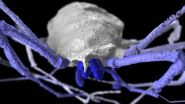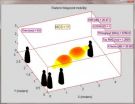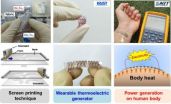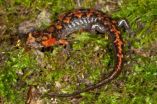(Press-News.org) DENVER (April 10, 2014) – Satellite city projects across the developing world are putting an increasing number of poor people at risk to natural hazards and climate change, according to a new study from the University of Colorado Denver.
Throughout Asia, Africa and Latin America `new towns' are rapidly being built on the outskirts of major cities with the goal of relieving population pressures, according to study author Andrew Rumbach, PhD, assistant professor of planning and design at CU Denver's College of Architecture and Planning.
The towns often sit in high flood risk zones but designers have minimized the dangers through land elevation, new building codes and quality construction. The problem, Rumbach says, are the informal settlements that invariably crop up beside these new cities and supply their labor force. When cyclones or monsoons occur, they suffer flooding along with diseases like cholera, hepatitis and dysentery.
"Clearly, we need to expand the scope of planning for these new cities to include the communities where the poor will live," said Rumbach, who specializes in dealing with natural hazards.
The study will be published in the July 2014 issue of the journal Habitat International and is already online at http://www.sciencedirect.com/science/article/pii/S0197397514000320.
Many nations are aggressively creating new towns. In India, the government has set an ambitious plan to build 100 of them with a million people each by 2020. Rumbach focused his research on Salt Lake, a fully mature new town on the outskirts of Kolkata (formerly Calcutta).
"Kolkata's current perspective plan calls for more than a dozen new town projects to be planned and developed on the city's periphery, settlements that may eventually house more than four million residents," the study said.
With a population of 300,000, Salt Lake is an affluent city, home to many of Kolkata's elite. It sits in an area of frequent flooding but drainage systems, underground sewers and elevated pumping stations mean it rarely suffers from natural disasters, said Rumbach who lived in Salt Lake during his study.
But two major slums – Dattabad and Kestopur - border the city and are home to many of construction workers, domestic help, food vendors and others who work in Salt Lake.
Rumbach interviewed 598 workers. The majority lived in slums and was employed in Salt Lake.
He found that most lived in cramped or crowded conditions which help spread diseases like influenza, cholera and tuberculosis, especially worrisome following heavy rain and floods. Houses were mostly made of concrete and brick with occasional cheap tile roofs. Electricity was sporadic and scarce. More than 80 percent of households in Dattabad and 100 percent of households in other settlements relied on toilets outside their homes, shared by dozens and sometimes hundreds of households.
"During flood events, open drains quickly overflow, contaminating nearby homes and open spaces with gray water and human waste," Rumbach said.
While the designers of Salt Lake anticipated the flood risks, they and planners of other new towns did not anticipate the thousands of low-income workers who would move to the area to work in the city.
"These workers are excluded from working in the township itself…so the increased hazard exposure associated with the low-lying terrain dramatically increases their risk to natural hazards," the study said. "Salt Lake's informal labor force is adversely affected by even routine hazards like monsoon rains. When a major cyclone strikes, as they do every century or so, the impact on these communities will likely be catastrophic."
Ultimately, Rumbach said, urban planners worldwide must anticipate the needs of low-income workers.
"The workforce is essential to everyday functioning of townships like Salt Lake," he said. "To reduce risks associated with new town development, planners must take these vulnerable groups into account."
INFORMATION:
The College of Architecture and Planning is among the largest colleges of architecture and related design and planning disciplines in the U.S. Located on the University of Colorado Denver's downtown campus and the University of Colorado-Boulder, CAP brings together faculty, students and practitioners who share common pursuits in communities of interest including: emerging practices in design, sustainable urbanism, the creation of healthy environments and the preservation of cultural heritage. CAP is one of 13 schools and colleges at CU Denver which offers more than 128 degrees. END
New towns going up in developing nations pose major risk to the poor
Housing projects expose low-income workers to natural disasters, disease
2014-04-10
ELSE PRESS RELEASES FROM THIS DATE:
Four-eyed daddy longlegs fossil fills in evolutionary tree
2014-04-10
Living harvestmen—a group of arachnids more commonly known as daddy longlegs—have a single pair of eyes that help them navigate habitats in every continent except Antarctica. But a newly described 305-million-year-old fossil found in eastern France shows that wasn't always the case. New research recently published in the journal Current Biology and led by scientists at the American Museum of Natural History and the University of Manchester indicates that primitive harvestmen had two pairs of eyes, adding significant details to the evolutionary story of this diverse and ...
New research on gigabit wireless communications
2014-04-10
Research on gigabit wireless communications has been presented by researchers from the University of Bristol at the world's leading wireless communications and networking conference, IEEE WCNC 2014, in Turkey earlier this week [Monday 6 to Wednesday 9 April].
The two research papers, led by Andrew Nix, Professor of Wireless Communication Systems and Dr Simon Armour, Senior Lecturer in Software Radio, from the University's Communication Systems and Networks research group in the Department of Electrical and Electronic Engineering, could have significant implications for ...
Thermoelectric generator on glass fabric for wearable electronic devices
2014-04-10
Wearable computers or devices have been hailed as the next generation of mobile electronic gadgets, from smart watches to smart glasses to smart pacemakers. For electronics to be worn by a user, they must be light, flexible, and equipped with a power source, which could be a portable, long-lasting battery or no battery at all but a generator. How to supply power in a stable and reliable manner is one of the most critical issues to commercialize wearable devices.
A team of KAIST researchers headed by Byung Jin Cho, a professor of electrical engineering, proposed a solution ...
Common sense health for young adult cancer survivors
2014-04-10
Many factors influence the life expectancy of childhood cancer survivors: not getting enough exercise, being underweight, and being worried about their future health or their health insurance. These are the findings of research led by Cheryl Cox of the St. Jude Children's Research Hospital in the US, published in Springer's Journal of Cancer Survivorship. The study found that, on average, childhood cancer survivors passed away before they were 40 years old.
Health-related behavior, self-perceived health status, and health concerns often influence mortality in the general ...
Iconic boreal bird species declining in the Adirondacks, study says
2014-04-10
A new study from the Wildlife Conservation Society finds that several iconic Adirondack birds are in trouble, with declines driven by the size of their wetland habitats, how connected these wetlands are to one another, and how near they are to human infrastructure.
The Adirondack Park represents the southern range extent for several species of boreal forest birds in eastern North America. Like any species at the edge of its range, they face challenges in this environment. The habitats of these boreal specialists – cool, wet, sphagnum-draped bogs and swampy woods – are ...
Uncovering a new angle on mental distance
2014-04-10
Why does the second hour of a journey seem shorter than the first? According to research from University of Toronto Scarborough (UTSC) and the Rotman School of Management, the answer lies in how we're physically oriented in space.
In a series of six studies, Sam Maglio, an assistant professor in UTSC's Department of Management, demonstrated that a person's orientation — the direction they are headed — changed how they thought of an object or event.
The research is forthcoming in Psychological Science, a journal of the Association for Psychological Science.
"Feeling ...
Sunlight generates hydrogen in new porous silicon
2014-04-10
Porous silicon manufactured in a bottom up procedure using solar energy can be used to generate hydrogen from water, according to a team of Penn State mechanical engineers, who also see applications for batteries, biosensors and optical electronics as outlets for this new material.
The surface area of this porous silicon is high," said Donghai Wang, assistant professor of mechanical engineering. "It is widely used and has a lot of applications."
The standard method for manufacturing porous silicon is a subtraction method, similar to making a sculpture.
"Silicon is ...
Extending terrorism insurance program could lower federal costs, study finds
2014-04-10
Federal spending after future terrorist attacks on the United States may be higher if the nation's terrorism risk insurance program is allowed to expire, according to a new RAND Corporation study.
The analysis finds that in a terrorist attack with losses up to $50 billion, the federal government would spend more helping to cover losses than if it had continued to support a national terrorism risk insurance program.
In the wake of the terrorist attacks of Sept. 11, 2001, terrorism risk insurance quickly became either unavailable or very expensive. Congress reacted by ...
Health of ecosystems on US golf courses better than predicted
2014-04-10
COLUMBIA, Mo. – Currently, there are more than 18,300 golf courses in the U.S. covering over 2.7 million acres. The ecological impacts of golf courses are not always straightforward with popular opinion suggesting that environmentally, golf courses have a negative impact on ecosystems. Now, researchers at the University of Missouri have determined that golf courses can offer a viable habitat for stream salamanders, and enhanced management practices may be beneficial to ecosystems within golf courses.
"If you look at the literature on golf courses, historically they get ...
Researchers bolster development of programmable quantum computers
2014-04-10
University of Chicago researchers and their colleagues at University College London have performed a proof-of-concept experiment that will aid the future development of programmable quantum computers.
Many complex problems are difficult and slow to solve using conventional computers, and over the last several years, research has grown steadily toward developing quantum computation. In particular, optimization problems such as the "traveling salesman" problem, which calculates the shortest possible route needed to visit a set of towns, become intractable as the number ...
LAST 30 PRESS RELEASES:
Injectable breast ‘implant’ offers alternative to traditional surgeries
Neuroscientists devise formulas to measure multilingualism
New prostate cancer trial seeks to reduce toxicity without sacrificing efficacy
Geometry shapes life
A CRISPR screen reveals many previously unrecognized genes required for brain development and a new neurodevelopmental disorder
Hot flush treatment has anti-breast cancer activity, study finds
Securing AI systems against growing cybersecurity threats
Longest observation of an active solar region
Why nail-biting, procrastination and other self-sabotaging behaviors are rooted in survival instincts
Regional variations in mechanical properties of porcine leptomeninges
Artificial empathy in therapy and healthcare: advancements in interpersonal interaction technologies
Why some brains switch gears more efficiently than others
UVA’s Jundong Li wins ICDM’S 2025 Tao Li Award for data mining, machine learning
UVA’s low-power, high-performance computer power player Mircea Stan earns National Academy of Inventors fellowship
Not playing by the rules: USU researcher explores filamentous algae dynamics in rivers
Do our body clocks influence our risk of dementia?
Anthropologists offer new evidence of bipedalism in long-debated fossil discovery
Safer receipt paper from wood
Dosage-sensitive genes suggest no whole-genome duplications in ancestral angiosperm
First ancient human herpesvirus genomes document their deep history with humans
Why Some Bacteria Survive Antibiotics and How to Stop Them - New study reveals that bacteria can survive antibiotic treatment through two fundamentally different “shutdown modes”
UCLA study links scar healing to dangerous placenta condition
CHANGE-seq-BE finds off-target changes in the genome from base editors
The Journal of Nuclear Medicine Ahead-of-Print Tip Sheet: January 2, 2026
Delayed or absent first dose of measles, mumps, and rubella vaccination
Trends in US preterm birth rates by household income and race and ethnicity
Study identifies potential biomarker linked to progression and brain inflammation in multiple sclerosis
Many mothers in Norway do not show up for postnatal check-ups
Researchers want to find out why quick clay is so unstable
Superradiant spins show teamwork at the quantum scale
[Press-News.org] New towns going up in developing nations pose major risk to the poorHousing projects expose low-income workers to natural disasters, disease




